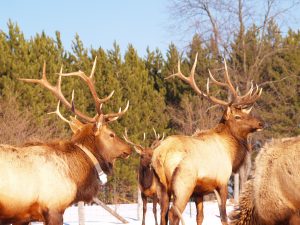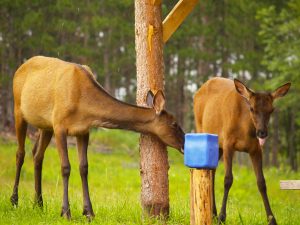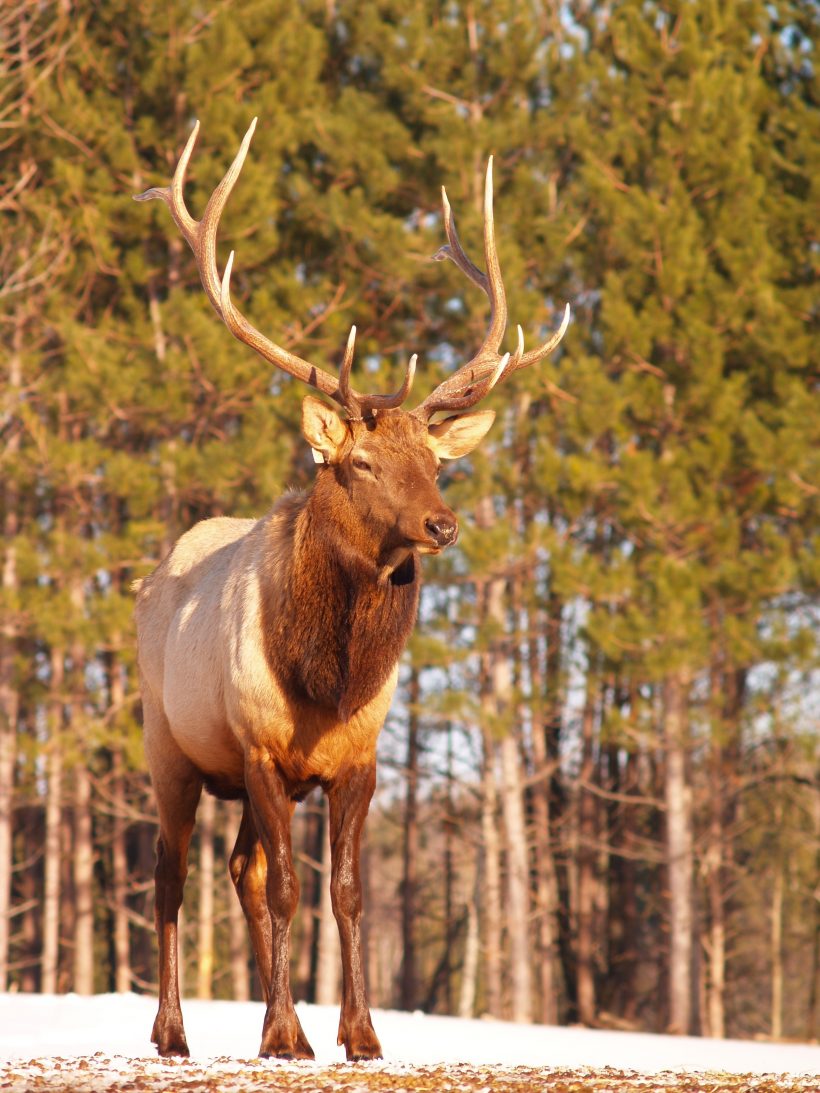TROUBLE in PARADISE?
Ever since they set foot on North Hastings territory the wild animals from Elk Island have been full of surprises. Readers may recall that the first elk down the unloading ramp headed for the enclosing fence and like the cow that jumped over the moon made its unanticipated exit from captivity and headed for parts unknown. One ultimately drowned in Quebec, another was killed crossing the 401, some headed for Haliburton and others simply remained close to the Gin (or Ginn) Lake site and gradually spread throughout the land. I can recall the excitement of John O’Donnell’s e-mail exclaiming the first sighting of an elk born near Fraser Lake. Trent U students were chasing all over North Hastings in search of the wandering elk pursuing their studies and the MNR was diligently collaring elk for research purposes with monies donated by volunteer private groups such as the Quinte Elk Restoration Committee. As literary writers might say, the air was electric.
Now, after years of successful and steady growth the North Hastings herd has grown (or groan as the case may be) to a substantial size that warrants the first elk hunt in Ontario since Richard Sloat shot one of the last legally recorded elk on Tuesday, November 2, 1970 “shortly after 10 a.m.” You can see that very same elk at the Mario Cortellucci Hunting and Fishing Heritage Centre in Peterborough.
But not everyone is joyous. Apparently Animal Alliance Canada thinks the herd needs special protection and the problem of animal/human conflict can be solved without a hunt. In its opinion the elk should be an endangered species. Listening to the CBC their spokesperson said that people must stop feeding the elk and the MNR should enforce the legislation that permits it to prosecute the offenders. Of course that would include the multitudes who feed deer throughout the province and, as it stands the few Conservation Officers that we do have are overextended as it is. The C.O.s would have to work 24/7 to try and stem that popular tide. As for such legislation Sr. Media Relations Officer Jolanta Kowalski told me that in December 2009 changes were made to the Fish and Wildlife Conservation Act (FWCA) (under the Good Government Act 2009) to allow the ministry to pass regulations to control inappropriate feeding of wildlife. The ministry has not yet drafted policy guidance to oversee the use of these new regulatory powers under the FWCA and any such policy would require public consultation. However, she points out, municipalities have the ability under the Municipal Act to regulate activities such as feeding within their boundaries to address local conflicts.

The AA spokesperson also mentioned that Kentucky waited until it had 7500 elk and then only issued 12 tags for its first hunt. If memory serves Kentucky manages for elk and elk alone whereas in Ontario the MNR manages for multi species (deer, moose, elk, caribou for example) which is far more challenging. Also, in neighboring Michigan, in 2010 they planned to issue 230 elk licenses. It’s difficult to compare elk management in the various jurisdictions. Each does what is most suitable for its responsibility.
The AA also complained that the Special Purpose Account (SPA), funded entirely by hunters, trappers and fisherfolk, has undue influence in such considerations to the exclusion of animal protection groups. Although both groups tend to be polar opposites they both have the same common denominator – the well being of animals. That’s why we have F&G PROTECTION Associations. Let’s compare some figures.
In the fiscal year 2007/08 – the F&W budget was $82 million. The government contributed $21 million from the Consolidated Revenue Fund (CRF), the SPA $61 million. In 2008/09 the F&W budget was $96 million – $32 M from the CRF, $64 M from the SPA. Where would F&W be without the SPA? How much has the AA contributed?
The spokesperson told the CBC that the only discussed solution to this elk/human conflict was hunting and she knows this because she sits on a committee that deals with animal/human conflicts. She didn’t identify whether this was a government committee or otherwise. In fact, the MNR has looked at trap and transfer (still a possibility I understand), the feeding issue, compensation to farmers and ways to discourage nuisance elk. Minister Jeffrey alluded to such in her CBC interview the following day. The hunt is not a step taken lightly. Other North American jurisdictions where elk have been hunted have indicated that once hunted the elk become very wild and shun human contact. We’ll see if that pans out here. Perhaps, had the AA jumped in earlier it could have compensated the farmers and perhaps changed the course of history?
On a final note – information gleaned from Dr. Scott Petrie’s presentation concerning the History of Wildlife Management in North America says that hunters were the first conservationists. I would add environmentalists as well. Today, he said, hunters contribute $12 to conservation for every loonie that a non-hunter contributes. “To date, hunters and fishermen have contributed more than $20 billion for wildlife conservation in North America. Hunters (5% of the Canadian population) provide about 45% of funding for management of ‘nongame’ wildlife.” What other group has such a track record?

2019 UP-DATE
Farmers in the Carlow farming area no longer complain about nuisance elk in their crops or damaging fencing. Hunting seems to have solved this issue. Also, since 2011 hunting interest has steadily declined and with no financial support from groups like Qunite Elk Restoration the GPS collars are failing and the now MNRF know even less about the North Hastings elk. FYI.
AND FINALLY….
“Work is for those who don’t fish.” – Anon.
